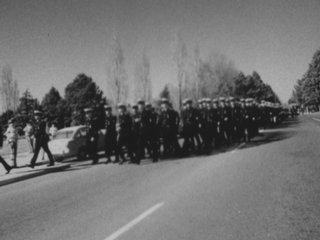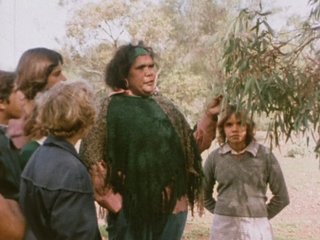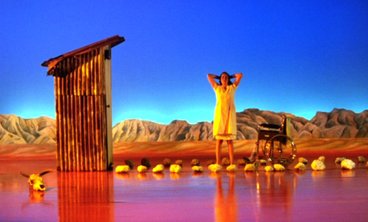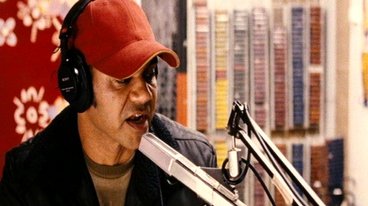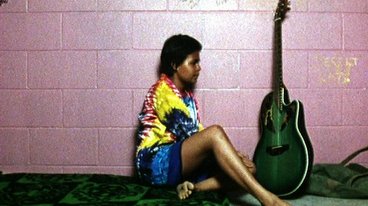A Short History of Indigenous Filmmaking
In a relatively short space of time, Australian films have jumped from depicting Indigenous peoples through racist clichés to Indigenous creatives using film and television to document their cultures, promote social change and to entertain, thus entering the mainstream. This is highlighted by recent critical and box-office hits such as Samson and Delilah (2009) and Bran Nue Dae (2009), which deal with complex Indigenous issues and feature Aboriginal actors and characters.
This reshaping of a cultural landscape and determined shift for Australian cinema’s national identity came about through a gradual reframing of Indigenous rights within the Australian legal system, combined with government support for the development of Indigenous filmmakers.
Early representations of Indigenous Australians on film were often played by non-Indigenous people in blackface and lacked any resemblance to the actual peoples or their customs and traditions. Unfortunately, this misinterpretation of Indigenous peoples and their cultures in turn influenced and perpetuated the broader population’s perceptions. When Indigenous people did get to play a major role in feature films, it was as the subordinate sidekick or a primitive savage. In either case, they were cast as racially inferior to the white characters. Leading film archivist Michael Leigh concluded in his essay ‘Curiouser and Curiouser’ in Back of Beyond, Discovering Australian Film and Television (1988):
These films, which today resemble Tropicana surrealism more than any possible reality, presented their ‘natives’ as the less-than-Noble Savage, cast generally as lazy, shiftless, crafty and filled with either lust or vague mystical foreboding … The Aboriginal became a stock symbol for the hostility Europeans so wrongly perceived in a landscape so different from that on which their own cultures were based. Being strangers in an even stranger land, these nomadic invaders used imagery as a sleight-of-hand to transfer their displacement and alienness to the Aborigines.
Australian government legislation played its part by severely limiting the capacity of Indigenous peoples to participate in society. In the 1960s, however, things began to change. The United Nations challenged all countries to recognise the human rights of their citizens. With mounting domestic pressure to divert international exposure, the Australian Government removed numerous discriminatory references from its laws and, through a referendum, from the Australian constitution. These changes alone failed to lessen the socio-economic disadvantage suffered by the majority of Aboriginal and Torres Strait Islander peoples or alter the broader population’s prejudice.
In the 1970s, a young and fiery generation of Aboriginal activists renewed the protest for Aboriginal land rights in Australia; they conveyed their political message through direct action and by utilising film and television. In 1972, Aboriginal people took their struggle to the lawns of Parliament House in Canberra and, via television and radio coverage, to the world. This media exposure rallied activists from the anti-war, civil rights and feminist movements, and enlisted new supporters from more conservative quarters. They joined Aboriginal activists in calling on the federal government to legislate Aboriginal land rights. The documentary Ningla A-Na (1972), produced and directed by Alessandro Cavadini, documents this historic event. The film contains the news footage of police overpowering and brutalising the protestors. Seen worldwide, the film highlighted to an international audience the Aboriginal struggle for land rights.
Aboriginal activists then spearheaded a new movement and initiated a revolution in Indigenous policy in Australia. The newly elected Whitlam government dumped the assimilation policy, opting instead for Aboriginal self-determination. Most importantly the Whitlam government domestically implemented human rights legislation in the form of the Racial Discrimination Act 1975. These legislative and policy changes created new opportunities for Aboriginal and Torres Strait Islander peoples.
Indigenous self-representation and self-empowerment in the arts began with Bruce McGuiness – a forerunner in Indigenous filmmaking – who made two films: Blackfire (1972) and A Time to Dream (1974). In the mid-1970s a small group of Indigenous people attended a workshop at the Black Theatre in Redfern, to gain access to training in the arts. Ande Reese documented this six-week workshop in her film Tjintu Pakani: Sunrise Awakening (1976). The students featured in Tjintu Pakani went on to influence, teach and mentor other Indigenous people, sharing their knowledge, skills and expertise across Australia and beyond. They became legendary trailblazers in the Indigenous arts world.
As Aboriginal and Torres Strait Islander activists advocated for self-representation in film, some non-Indigenous filmmakers responded by facilitating the process. The most outstanding of these early collaborations include Martha Ansara and Essie Coffey with My Survival as an Aboriginal (1978), and Alec Morgan and Gerry Bostock with Lousy Little Sixpence (1983). These films provide an alternate perspective on Indigenous cultures, stories and histories.
In the early 1980s, the Film Unit of the Australian Institute of Aboriginal Studies (AIAS, now the Australian Institute of Aboriginal and Torres Strait Islander Studies) employed a number of trainees including Wayne Barker and Coral Edwards. Coral Edwards directed It’s a Long Road Back (1981) and, in collaboration with AIAS ethnographic filmmaker David MacDougall, Link-up Diary (1987). Wayne Barker worked on several AIAS films and directed a film about his grandfather, Cass: No Saucepan Diver (1983). After leaving AIAS, Barker wrote and directed another ten films. His documentaries Milli Milli (1994) and Spirit of Anchor (2002) received a number of international awards.
With a background in commercial television, Ralph Rigby, AIAS Video Fellow in the 1980s, facilitated rural and remote Aboriginal community access to video technology. In doing so, he enabled Indigenous peoples to tell their stories in their own way. His video clip for Bobby McLeod’s song 'Wayward Dreams’ (1988) blended historical footage and contemporary images to highlight the connection between Aboriginal peoples of the past and present. Rigby, a student at the Black Theatre in Redfern and in Ande Reese’s film Tjintu Pakani: Sunrise Awakening (1976), later worked with the Townsville Aboriginal and Islander Media Association (TAIMA) where he managed the Video Unit and taught video production to Aboriginal and Torres Strait Islander trainees. In 1988, Rigby and the TAIMA Video Unit trainees worked on three productions covering the 5th Festival of Pacific Arts in Townsville.
Madeline McGrady directed a number of politically motivated films throughout the 1980s including We Fight (1982), Welcome to Wee Waa (1983), Stand Up For Your Rights (1987) and Always Was, Always Will Be (1987). In making these films McGrady claimed space for Indigenous activism within the film industry. Lorraine Mafi-Williams produced Eelemarni, The Story of Leo and Leva (1988), a short video of a Bundjalung story told in both Bundjalung language and in English. Around the same time, Tracey Moffatt directed a series of short films including Nice Coloured Girls (1987), Night Cries: A Rural Tragedy (1990) and the feature film BeDevil (1993). McGrady, Mafi-Williams and Moffatt paved the way for Aboriginal women in the film industry.
The mid-1980s brought the establishment of the Central Australian Aboriginal Media Association (CAAMA) in Alice Springs. CAAMA aimed to utilise audiovisual technology for cultural maintenance, self-expression and empowerment. Soon after, CAAMA moved into television broadcasting with Imparja Television. As a result CAAMA became the first Indigenous organisation in the world to own a television station. In 1987, Aboriginal people in remote areas of central Australia voiced their concerns about the influence of mass media on their cultures. The Australian satellite Aussat was being launched and Aboriginal people requested resources to enable them to broadcast local material in their own languages. They also sought to control the content broadcast within their communities. In response, the federal government introduced the Broadcasting for Remote Aboriginal Communities Scheme to deliver radio and television to rural and remote Aboriginal and Torres Strait Islander communities.
The Royal Commission into Aboriginal Deaths in Custody outlined in its final report (1991) a number of recommendations with direct reference to public and commercial media organisations and their treatment of Indigenous people. The commission recommended that media bodies develop codes and policies for the presentation of Indigenous issues and establish training for Indigenous people. These recommendations marked a turning point in the television industry. They supported Indigenous peoples having influence over their own representation and increased their access to employment within the film and television industry.
In a landmark decision in 1992, the High Court of Australia recognised that Indigenous property rights extended beyond British settlement until extinguishment – in some cases into the present. The same year the Australian Film Commission commissioned a report by Shirley McPherson and Michael Pope, Promoting Aboriginal and Torres Strait Islander Involvement in the Film and Television Industry (1992). On its recommendation, the AFC established the Indigenous Branch in 1993. After decades on the fringes of the film and television industry, Aboriginal and Torres Strait Islander people were finally gaining access to the technology, training and resources necessary to write, direct and produce film. The branch’s first drama initiative saw six short films released in 1996 under the title From Sand to Celluloid.
As manager of the branch, Walter Saunders also produced the subsequent series Shifting Sands (1998) and Crossing Tracks (1999). These groundbreaking and award-winning short films established an Indigenous niche in the industry and forged a pathway for the development of Indigenous filmmakers and film administrators. With the release of Terri Janke’s A Guide to Protocols for Filmmakers Working with Indigenous Content and Indigenous Communities (2008), the AFC (now part of Screen Australia) continued to guide the industry on culturally appropriate practice and to develop a critical mass of Indigenous filmmakers.
These filmmakers offer Australians an alternative way of seeing and understanding Indigenous peoples and their cultural landscapes. Celebrated Aboriginal and Torres Strait Islander filmmakers include Rachel Perkins, Warwick Thornton, Murray Lui, Ivan Sen, Wayne Blair, Beck Cole and the late Michael Riley. Films like Perkins’s Bran Nue Dae (2009) and Thorton’s Samson and Delilah (2009) cast Indigenous characters in the lead roles and set their stories within an Indigenous community and cultural context. In doing so these filmmakers have completely repositioned the on-screen presence of Indigenous characters, taking them from peripheral to central roles.
The establishment of National Indigenous Television (NITV), owned and operated by Indigenous Australians, marks the beginning of a new era in self-representation. This national mainstream television service generates substantial work for both Indigenous and non-Indigenous industry practitioners.
As we enter the second decade of the 21st century, Australian Aboriginal filmmakers stand on solid ground within the Australian film and television industry, as they continue to write, direct and produce television series, shorts, documentaries and feature films. Thanks to the Indigenous trailblazers who rallied for the creation of training and education opportunities in the film industry, many of these individuals continue to nurture the development of emerging Indigenous talent. As a new generation of Australians gains an increased understanding and awareness of Indigenous peoples and their cultures, the identity of the Australian cinema will continue to undergo further transformation.
Titles in this collection

BeDevil 1993
Tracey Moffatt, who is best known as an artist, challenged Western storytelling traditions in Bedevil and polarised critics.

Bran Nue Dae 2009
An uplifting musical about an Indigenous boy’s journey back home, Bran Nue Dae encourages the audience to relax, get on board and enjoy the ride.

Crocodile Dreaming 2006
A short film highlighting the role of traditional custodians in maintaining balance between the natural and spiritual worlds.

First Australians – Episode 1, They Have Come to Stay 2008
The opening episode of this landmark television series explores the first contact, meetings and relationships between the British and the first Australians.

First Australians – Episode 2, Her Will to Survive 2008
This episode covers the period from 1825–60 and European settlement in Tasmania, told through the stories of Truganini and George Augustus Robinson.

First Australians – Episode 3, Freedom For Our Lifetime 2008
Episode 3 focuses on the first Australians of Victoria and the lives of Simon Wonga and William Barack.

First Australians – Episode 4, No Other Law 2008
This episode examines the coming of the telegraph pole and white settlement to Central Australia.

First Australians – Episode 5, Unhealthy Government Experiment 2008
This episode explores the lives of Jandamarra, an Aboriginal stockman, and Gladys Gillian, an institutionalised half-caste.

First Australians – Episode 6, A Fair Deal for a Dark Race 2008
Episode 6 of First Australians explores Indigenous history from 1930–67, primarily in the south-eastern regions of Australia.

First Australians – Episode 7, We Are No Longer Shadows 2008
The final episode of First Australians covers the period 1967–93 and Eddie Mabo’s fight for land rights.

From Sand to Celluloid – Black Man Down 1996
This short experimental drama offers a spiritual alternative to fighting the system. To overcome injustice, return to your spiritual roots for healing to take place.

From Sand to Celluloid – No Way to Forget 1996
Writer-director Richard J Frankland drew on his experience as a field officer for the Royal Commission into Deaths in Custody to compose this story.

From Sand to Celluloid – Payback 1996
Payback, a black-and-white short about the Western and Indigenous legal systems, is one of Warwick Thornton’s earliest dramatic works.

From Sand to Celluloid – Round Up 1995
Round Up is a lighthearted short drama that deals with the cultural clash between a white stockman and an Indigenous stockman.

From Sand to Celluloid – Two Bob Mermaid 1996
In this visually stunning short film set in the 1950s, a fair-skinned Aboriginal girl gains access to the local swimming pool where Aboriginal people are legally denied access.

Lousy Little Sixpence 1983
Lousy Little Sixpence highlights the injustice of withheld wages, and the fight for rightful payment to be made to Indigenous peoples.

My Survival as an Aboriginal 1978
The first documentary directed by an Indigenous woman offers a solution by way of continuing cultural practice.

Nice Coloured Girls 1987
The tongue-in-cheek title of Tracey Moffatt’s first film positions Aboriginal women as naïve and 'nice’ but these are merely roles played by the women.

Night Cries: A Rural Tragedy 1989
Tracey Moffatt continues to challenge the social construction of Aboriginality and how it is viewed nationally and internationally. Night Cries is a possible sequel to Jedda.

Ningla A-Na 1972
Ningla A-Na documents the activism of the Black movement in south-east Australia in the 1970s and shows how the activists changed the direction of the movement both nationally and internationally.

One Night the Moon 2001
One Night the Moon, from director Rachel Perkins, reintroduces song into the Australian landscape. For Indigenous peoples, song has been one of the central means of land management.

Radiance 1998
This is a rare exploration of the emotional interior lives of Indigenous women, in this case, three sisters.

Samson and Delilah 2009
A heartbreaking and thought-provoking film about two Indigenous teenagers growing up in central Australia.

Shifting Sands – Grace 1998
This short drama from Wesley Enoch depicts the emotional journey of an Indigenous woman back to Australia for the funeral of her sister.

Shifting Sands – My Bed Your Bed 1998
This short romantic drama from Erica Glynn uses the power of silence to communicate the tension between two characters who have been promised to each other.

Shifting Sands – My Colour, Your Kind 1998
When under threat of having their children stolen by authorities, Indigenous mothers resorted to darkening their fair-skinned children with mud and charcoal.

Shifting Sands – Passing Through 1998
A directorial debut from filmmaker and celebrity chef Mark Olive, Passing Through weaves myth and legend to tell an Indigenous-flavoured ghost story.

Shifting Sands – Promise 1997
This is essentially a love story told in the absence of the love interest – grandfather – that resonates as one of those moments that are a cherished memory.

Shifting Sands – Tears 1997
Tears introduces the two main characters from Ivan Sen’s feature film Beneath Clouds, and also presents the elements that shape his later feature.


